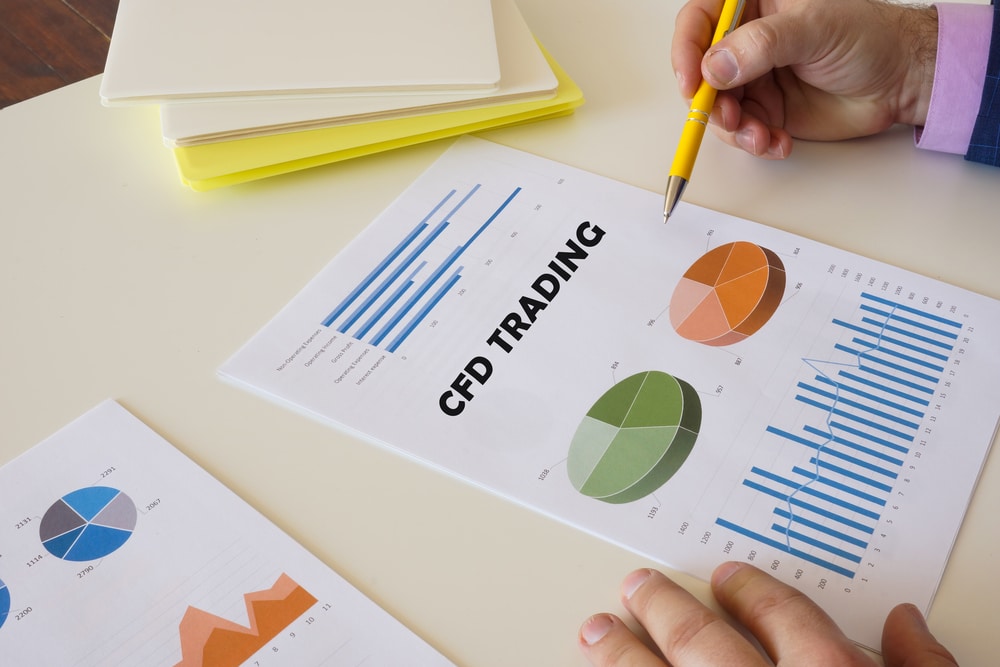
Contracts for Difference (CFDs), are forms of trade based on speculating short-term price changes of assets. This form is highly dependent on margin trading and leverage and does not involve actual handling of the assets involved.
If you’re looking to create a position in CFDs, you simply need to deposit a fraction of the total value of the transaction. This is also commonly known as margin trading. With it, you increase the size of your potential profits, but also increase your risk exposure. This is because the same factor also raises the potential losses as profit.
Forex trading CFDs
Forex CFDs are characteristically built on high leverage. The value of CFD instruments is based on the value of the asset they follow. You can go long on a currency pair, in which case you will buy it, or go short, in which case you will sell it. It all depends on your assessment of the market. Once you choose your position, it will be tethered to the currency rates in the spot market.
Buyers and sellers trade currencies in the spot FX market. Over-the-counter trading takes place in an unregulated and unmonitored environment. As a result, transactions in the FX market are not settled in the exchange as they are in the stock market. Instead, FX transactions are resolved bilaterally.
The interbank market accounts for the vast majority of currency market transactions. This is where the orders of banks and other major financial institutions take place.
An understanding of how the spot foreign exchange market operates is essential to understanding forex CFD trading. Entities in this market do not actually exchange hard cash. Instead, depending on how the market moves relative to your position, your trading account is simply credited or debited with the amount.
This market publishes the pricing at which players engage in transactions. Banks also follow this routine and they publish their rates for different currencies in the form of bid and ask prices. The bid price is the bank’s offer to buy while the ask price is the price at which they sell.
This means that other participants can purchase and sell at the ask and bid prices, respectively, if they so desire.
The contract is based on the current market price in a spot currency transaction. Settlement in the interbank market occurs two days after the deal is finalized.
Margin and leverage
Trading CFDs is a form of leveraged trading. You’ve probably heard about this before.
Leverage is the ability to control a larger financial position without having to put up the entire amount at once. For instance, a standard lot of the GBPUSD pair goes for $100,000.
This is an amount that most retail traders don’t have at their disposal. Leverage can be used to manage the $100,000 position in forex CFDs. Leverage is the amount of money that your forex broker lends you. As an alternative, you only need to put up a small portion of the whole cost.
With 1:50 leverage, a trader with $1,000 in their account can open a position worth $50,000. In this case, the broker matches every dollar trade with $50. To trade in forex without leverage, you’ll need a substantial amount of money.
Working example 1: Long position
Let’s take the case of a long position on the GBPUSD pair. Taking a long position in the British pound will be a good idea if you believe that the GBP currency would appreciate against the US dollar.
Suppose the GBPUSD pair is going at 1.3400. You go long on the pair at 1.3400 because you believe the price will appreciate in the next ten hours.
Ten hours later, the exchange rate changes to 1.3420. That is equivalent to 20 pip movement. If you used the leverage and traded one standard lot, you would have made $200. In contrast, if the rate had gone down to 1.3390, you would have incurred a loss of $100.
Working example 2: Short position
If a trader takes a short position, it means that they are confident that a particular currency will lose value. Let’s assume that you believe that the British pound will depreciate against the dollar. You, therefore, decide to short the GBPUSD pair.
Working with our example above, if you short GBPUSD with the rate at 1.3400 and it goes down to 1.3390, you get a ten pip movement. That is equivalent to a profit of $100 on a single lot. In contrast, if the British pound appreciates instead and the rate rises to 1.3410, the ten pip movement would be against your position. You would therefore incur a loss of $100 on your standard lot.
Traders utilize stop losses and take profits while trading forex CFDs. This is a type of limit order that is activated when the price reaches a certain level. A stop-loss order is an order that limits the amount of money you can lose on a trade.
A take-profit order is also a type of limit order. It is triggered when the market moves in favor of your position and reaches the level you had set as ideal for taking the profit.
In summary
If you’re looking for a means to speculate on financial markets without having to acquire and sell any assets, CFD trading is for you. When trading in this market, the supply and demand of the connected asset play a crucial role in determining their price. Leverage and margin are critical to the success of CFD trading.








Leave a Reply